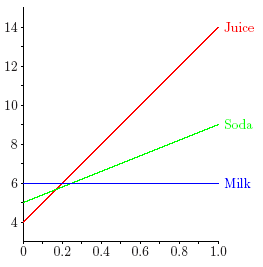
The three methods we have discussed so far -- plurality, anti-plurality, and Borda count -- can all be described in the same way. If a voter ranks a candidate as their top choice, that candidate gets 1 point. Candidates get 0 points for being bottom-ranked. If a candidate is ranked in the middle, they receive a number of points between 0 and 1:
In the positional method, a candidate receives s points for being second-ranked by a voter, where s is a value between 0 and 1. This method is sometimes called the (1, s, 0)-method for the points assigned to the first, second, and third-place choices.
How do various values of s affect the "milk, soda, juice" example? Consider the graph below.

Along the horizontal axis is the value of s, and along the vertical axis is the total for each candidate. Notice that by changing the value of s we can change the winner of the election with adding or removing voters.
In the interactive diagram below, experiment with changing the value of s. Can you find profiles where you can change the winner of the election, not by adding or removing voters, but by simply changing the value of s?
While the positional method generalizes all of the methods we have discussed so far, there is another way to think about the winner of an election with more than two candidates. On the next page we will discuss pairwise elections and the Condorcet winner.